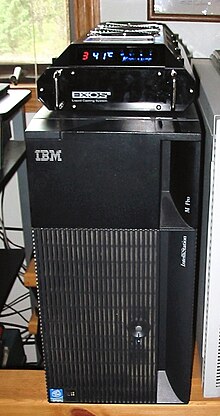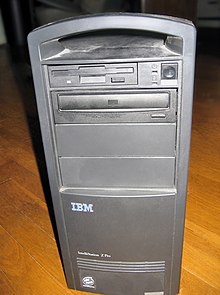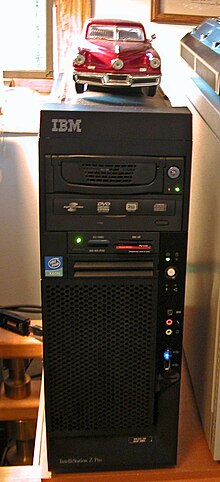Workstations family by IBM
The IntelliStation is a family of workstations developed by IBM and first released in March 1997 as the follow-on to the PC Series 360 and 365. Certain IntelliStation M Pro Series were near hardware identical to low end IBM Netfinity 1000 Series network servers (with variants in included video cards and SCSI options). [ 1] In February 2002, POWER processor-based workstations, previously sold directly under the eServer pSeries brand, were also placed under the IntelliStation umbrella.
The last IntelliStation models were discontinued in January 2009, ending the product line. [ 2]
IBM IntelliStation models list Sockets Position 1997 1998 1999 2000 2001 2002 2003 2004 2005 2006 2007 2008 2009 x86-based 1 Entry E 6893 E 6893; E 6867
E 6836–6846; E 6204–6214
E 6216–6226 Midrange M 6888 M 6849; M 6231;
M 6233
M 6229; M 6219
M 6220–6230; M 6218
M 6225; M 9229
Rackmount R 8654 R 6851 2 Midrange M 6898 M 6889 M 6889 M 6850 AMD-based A 6224 A 6217 High-end Z 6899 Z 6865 Z 6866 Z 6221 Z 6223; Z 9228
Itanium -based 2 High-end Z 6894 Power-based 1 OR 2 Midrange 185 (7047) High-end 275 (9114) 285 (9111) 2 265 (9112)
IntelliStation Pro Intel or AMD processor based workstations, discontinued in March 2008.
IntelliStation A Pro Type 6224 (March 2004 to July 2005)
Dual AMD Opteron Models 244, 246, 248, 250 and 256 (no dual-core support) Up to 16 GB PC3200 memory Ultra320 SCSI or SATA 150 HDD 10/100/1000 Mbit Ethernet Graphic adapter options: Nvidia Quadro NVS 280 Nvidia Quadro FX 1100 Nvidia Quadro FX 3000 Nvidia Quadro FX 4000 Type 6217 (April 2005 to April 2007)
Dual AMD Opteron Models 250, 252, 254, 256 or dual-core Model 275, 280 or 285 Up to 16 GB PC3200 memory Ultra320 SCSI or SATA 150 HDD 10/100/1000 Mbit Ethernet Graphic adapter options: Nvidia Quadro NVS 280 Nvidia Quadro NVS 285 Nvidia Quadro FX 1400 Nvidia Quadro FX 1500 Nvidia Quadro FX 3400 Nvidia Quadro FX 3500 Nvidia Quadro FX 4500 Nvidia Quadro FX 4500 X2 3DLabs Wildcat Realizm 800 IntelliStation E Pro Type 6893 (June 1998 to June 1999)
Type 6893 (March 1999 to June 2000)
Type 6867 (November 1999 to November 2000)
Type 6836–6846 (October 2000 to January 2002)
Type 6204–6214 (September 2001 to September 2002)
Type 6216–6226 (July 2002 to October 2003)
Intel Pentium 4 at 2.0, 2.26, 2.4, 2.67 or 2.8 GHz Up to 2 GB PC2100 memory Ultra160 SCSI or ATA100 HDD 10/100/1000 Mbit Ethernet Graphic adapter options: Matrox Millennium G450 Nvidia Quadro 4 200NVS Nvidia Quadro 4 280NVS Nvidia Quadro 4 580XGL ATI FireGL 8800 IntelliStation M Pro Type 6888 (May 1997 to July 1998)
Type 6898 (October 1997 to October 1998)
Type 6889 (July 1998 to June 1999)
Type 6889 (March 1999 to June 2000)
Type 6889 (October 1999 to June 2000)
Type 6849 (November 2000 to June 2002)
Intel Pentium 4 at 1.4, 1.5, 1.7, 1.8, 2.0 or 2.2 GHz Ultra160 SCSI or ATA100 HDD Up to 2 GB RDRAM 10/100 Mbit Ethernet Graphic adapter options: Matrox Millennium G450 IBM/Diamond Fire GL2 IBM/Diamond Fire GL4 Nvidia Quadro2 MXR Nvidia Quadro2 Pro Nvidia Quadro4 200NVS ATI FireGL 8800 3Dlabs Wildcat III 6110 Type 6850 (July 2001 to January 2003)
IBM 6850 M-Pro Dual Intel Xeon at 1.5, 1.7, 2.0 or 2.8 GHz Ultra160 SCSI or ATA100 HDD Up to 4 GB RDRAM 10/100 Mbit Ethernet Graphic adapter options: Matrox Millennium G450 IBM/Diamond Fire GL4 Nvidia Quadro2 Pro Nvidia Quadro4 200NVS ATI FireGL 8800 3DLabs Wildcat III 6110 Type 6231 (November 2001 to July 2002)
Type 6233 (November 2001 to July 2002)
Type 6229 (May 2002 to February 2003)
IBM IntelliStation M Pro 6219 Type 6219 (November 2002 to October 2003)
Intel Pentium 4 at 2.4, 2.67, 2.8 or 3.06 GHz Up to 4 GB PC2100 memory Ultra320 SCSI or ATA100 HDD 10/100/1000 Mbit Ethernet Graphic adapter options: Matrox Millennium G450 Nvidia Quadro4 280NVS Nvidia Quadro4 580XGL Nvidia Quadro4 980XGL 3DLabs Wildcat4 7110 Type 6220–6230 (July 2003 to March 2005)
Intel Pentium 4 at 2.8, 3.0, 3.06, 3.2 or 3.4 GHz Up to 4 GB PC2700 memory Ultra320 SCSI , ATA100 or SATA 150 HDD 10/100/1000 Mbit Ethernet graphic adapter options: NVIDIA Quadro4 280NVS NVIDIA Quadro4 580XGL NVIDIA Quadro4 980XGL NVIDIA Quadro FX 500 NVIDIA Quadro FX 1000 NVIDIA Quadro FX 1100 NVIDIA Quadro FX 3000 Type 6225 (October 2004 to March 2006)
Intel Pentium 4 with Intel 64 (formerly EM64T) at 3.0, 3.2, 3.4, 3.6 or 3.8 GHz Up to 4 GB PC2-3200 memory Ultra320 SCSI or SATA 150 HDD 10/100/1000 Mbit Ethernet graphic adapter options: NVIDIA Quadro NVS 280 NVIDIA Quadro FX 1300 NVIDIA Quadro FX 1400 NVIDIA Quadro FX 3400 ATI FireGL V3100 ATI FireGL V7100 3DLabs Realizm 800 Type 6218 (August 2005)
Intel Pentium 4 with Intel 64 (formerly EM64T) at 3.0, 3.2, 3.4, 3.6 and 3.8 GHz or dual-core 3.2 or 3.4 GHz Up to 8 GB PC2-4200 memory Ultra320 SCSI or SATA 300 HDD 10/100/1000 Mbit Ethernet graphic adapter options: NVIDIA Quadro NVS 280 NVIDIA Quadro NVS 285 NVIDIA Quadro FX 1400 NVIDIA Quadro FX 4500 ATI FireGL V3100 ATI FireGL V7100 3DLabs Realizm 800 Type 9229 (September 2006)
Intel Core 2 Duo with E6300, E6400, E6600, E6700 or Q6600 processor Up to 8 GB PC2-5300 memory 3Gbit SAS or SATA 300 HDD 10/100/1000 Mbit Ethernet graphic adapter options: NVIDIA Quadro NVS 285 NVIDIA Quadro FX 550 NVIDIA Quadro FX 1500 NVIDIA Quadro FX 3500 IntelliStation Z Pro Type 6899 (March 1997 to ??)
IntelliStation Z pro 6899 - based on a IBM Aptiva desktop. Type 6865 (October 1998 to April 2000)
Dual Intel Pentium II Xeon at 400, 450, 500 or 550 MHz (100 MHz FSB) Up to 2 GB SDRAM Ultra-2 SCSI HDD 10/100 Mbit Ethernet Graphic adapter options: Matrox Millennium G200 Matrox Millennium G400 Intergraph Intense3D Pro3400 Intergraph Intense3D Pro3400/GA IBM/Diamond Fire GL1 3DLabs Intense 3D Wildcat 4000 (RA and GA) Type 6866 (January 2000 to March 2002)
Dual Intel Pentium III Xeon at 677, 733, 800, 866, 933 MHz, or 1 GHz (133 MHz FSB) Up to 2 GB RDRAM Ultra160 SCSI HDD 10/100 Mbit Ethernet Graphic adapter options: Matrox Millennium G400 Matrox Millennium G450 IBM/Diamond Fire GL1 IBM/Diamond Fire GL2 ELSA GLoria II 3DLabs Intense 3D Wildcat 4110 3Dlabs Intense 3D Wildcat 4210 NVIDIA Quadro2 MXR Type 6894 (May 2001 to June 2002)
The only Itanium-equipped model, with the same platform as an identical Dell, Fujitsu or HP workstations, and based on a SGI reference design; [ 3] the main difference between vendor variants was only a hardware support, software options and case colors.
Type 6221 (November 2002 to February 2005)
IBM Z Pro 6221 - based on a IBM xSeries tower servers Dual Intel Xeon at 2.4, 2.67, 2.8 or 3.2 GHz Up to 8 GB PC2100 memory Ultra320 SCSI or ATA100 HDD 10/100/1000 Mbit Ethernet Graphic options (AGP-based): Matrox Millennium G450 NVIDIA Quadro4 280NVS NVIDIA Quadro4 980XGL NVIDIA Quadro FX 1000 NVIDIA Quadro FX 1100 NVIDIA Quadro FX 3000 3DLabs Wildcat4 7110 Type 6223 (August 2004 to March 2007)
Dual Intel Xeon with Intel 64 (formerly EM64T) at 3.0, 3.2, 3.4, 3.6 or 3.8 GHz Up to 16 GB PC2-3200 memory Ultra320 SCSI or ATA100 HDD 10/100/1000 Mbit Ethernet Graphic options (PCI-e based): NVIDIA Quadro4 NVS280 NVIDIA Quadro4 NVS285 NVIDIA Quadro FX 1300 NVIDIA Quadro FX 1400 NVIDIA Quadro FX 3400 NVIDIA Quadro FX 3500 NVIDIA Quadro FX 4500 ATI FireGL V7100 3DLabs Wildcat Realizm 800 Type 9228 (June 2006)
Dual Intel Xeon Model 5130, 5140, 5150 or 5160 Up to 32 GB PC2-5300 memory 3Gbit SAS or SATA 300 HDD 10/100/1000 Mbit Ethernet graphic options (PCI-e based): NVIDIA Quadro NVS 285 NVIDIA Quadro FX 550 NVIDIA Quadro FX 1500 NVIDIA Quadro FX 3500 NVIDIA Quadro FX 4500 This page is based on this
Wikipedia article Text is available under the
CC BY-SA 4.0 license; additional terms may apply.
Images, videos and audio are available under their respective licenses.




